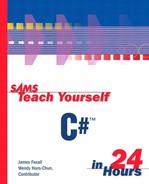Understanding Objects
Object-oriented programming has been a technical buzzword for quite some time. Almost everywhere you look—the Web, publications, books—you read about objects. What exactly is an object? Strictly speaking, it is a programming structure that encapsulates data and functionality as a single unit and for which the only public access is through the programming structure's interfaces (properties, methods, and events). In reality, the answer to this question can be somewhat ambiguous because there are so many types of objects—and the number grows almost daily. However, all objects share specific characteristics, such as properties and methods.
The most commonly used objects in Windows applications are the form object and the control object. Earlier hours introduced you to working with forms and controls and even showed you how to set form and control properties. In your Picture Viewer project from Hour 1, for instance, you added a picture box and two buttons to a form. Both the PictureBox and the Button control are control objects, but each is a specific type of control object. Another, less-technical example uses pets. Dogs and cats are definitely different entities (objects), but they both fit into the category of Pet objects. Similarly, text boxes and buttons are each a unique type of object, but they're both considered a control object. This small distinction is important.
